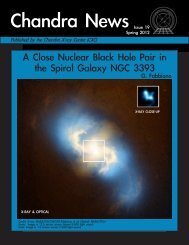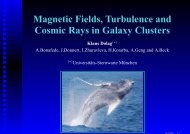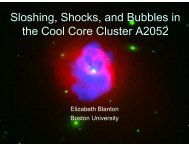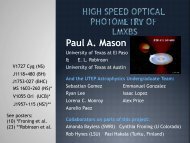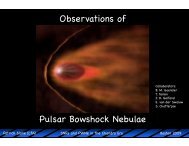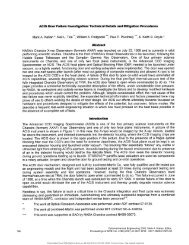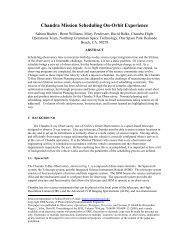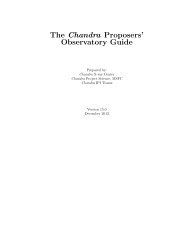PDF presentation - Chandra X-Ray Observatory (CXC)
PDF presentation - Chandra X-Ray Observatory (CXC)
PDF presentation - Chandra X-Ray Observatory (CXC)
Create successful ePaper yourself
Turn your PDF publications into a flip-book with our unique Google optimized e-Paper software.
Optical studies of an<br />
ultraluminous X-ray source:<br />
NGC1313 X-2<br />
Jifeng Liu<br />
Harvard-Smithsonian Center for Astrophysics<br />
in collaboration with<br />
Joel Bregman, Jon Miller, Philip Kaaret
outline<br />
• background: ultraluminous X-ray sources<br />
• a case study: NGC1313 X2<br />
• X-ray observations<br />
• optical observations<br />
• astrometry<br />
• photometry<br />
• color-magnitude diagram<br />
• spectral energy distribution<br />
• discussion<br />
• IMBH formation<br />
• period?<br />
• radial velocity
ultraluminous X-ray sources
ultraluminous X-ray sources<br />
• ULXs are non-nuclear X-ray point sources with Lx ><br />
2 X 10 39 erg/s, i.e., more luminous than the Eddington<br />
luminosity for stellar mass black holes, and could be intermediate<br />
mass black holes of 30 - 10 5 Ms
ultraluminous X-ray sources<br />
• ULXs are non-nuclear X-ray point sources with Lx ><br />
2 X 10 39 erg/s, i.e., more luminous than the Eddington<br />
luminosity for stellar mass black holes, and could be intermediate<br />
mass black holes of 30 - 10 5 Ms<br />
• key questions
ultraluminous X-ray sources<br />
• ULXs are non-nuclear X-ray point sources with Lx ><br />
2 X 10 39 erg/s, i.e., more luminous than the Eddington<br />
luminosity for stellar mass black holes, and could be intermediate<br />
mass black holes of 30 - 10 5 Ms<br />
• key questions<br />
• are they stellar mass black holes or IMBHs
ultraluminous X-ray sources<br />
• ULXs are non-nuclear X-ray point sources with Lx ><br />
2 X 10 39 erg/s, i.e., more luminous than the Eddington<br />
luminosity for stellar mass black holes, and could be intermediate<br />
mass black holes of 30 - 10 5 Ms<br />
• key questions<br />
• are they stellar mass black holes or IMBHs<br />
• how do they form if IMBH?
ultraluminous X-ray sources<br />
• ULXs are non-nuclear X-ray point sources with Lx ><br />
2 X 10 39 erg/s, i.e., more luminous than the Eddington<br />
luminosity for stellar mass black holes, and could be intermediate<br />
mass black holes of 30 - 10 5 Ms<br />
• key questions<br />
• are they stellar mass black holes or IMBHs<br />
• how do they form if IMBH?<br />
• how do they radiate if stellar mass black holes?
ULXs in NGC1313<br />
• a barred SB(s)d galaxy at 3.7Mpc<br />
• low metallicity of 0.1-0.2 Zs<br />
• irregular SW satellite regions - a<br />
tidally disrupted companion galaxy? a<br />
collision of huge HI clouds with the disk?<br />
• ULXs: X1, X2, and SN1978K
ULXs in NGC1313<br />
• a barred SB(s)d galaxy at 3.7Mpc<br />
• low metallicity of 0.1-0.2 Zs<br />
• irregular SW satellite regions - a<br />
tidally disrupted companion galaxy? a<br />
collision of huge HI clouds with the disk?<br />
• ULXs: X1, X2, and SN1978K<br />
X1<br />
X2<br />
SN1978K
X-ray observations: light curves<br />
Zampieri et al. 2004
X-ray observations: light curves<br />
XMM<br />
Feng & Kaaret 2006
X-ray observations: spectroscopy<br />
• light curves<br />
• observed since EINSTEIN<br />
• variability on time scales from days<br />
to months to years<br />
• maximum Lx up to 3x10 40 erg/s<br />
• X-ray spectra<br />
• can be fitted with a power-law (Γ~2.3,<br />
63%) plus a cool accretion disk (~160<br />
eV, 37%) suggestive of a IMBH of<br />
~10 3 Ms (Miller et al. 2003)<br />
• but the cool accretion disk component<br />
is dominated by the power-law<br />
component, and the fit is not unique<br />
• it can also be fitted with a power-law<br />
(Γ~2.9,64%) plus a hot disk (~2.7 keV,<br />
36%). (Stobbart et al. 2006)
optical observations
optical observations<br />
ESO 3.6m R<br />
counterpart: C (later resolved to C1 and C2)<br />
Zampieri et al. 2004
optical observations<br />
ESO VLT true-color image<br />
Pakull et al. 2006
optical observations
optical observations: astrometry
optical observations: astrometry
optical observations: astrometry
optical observations: astrometry<br />
x3: foreground star<br />
x4: background AGN
optical observations: astrometry
optical observations: astrometry
optical observations: astrometry<br />
Counterpart: C1
optical observations:<br />
environments
optical observations:<br />
environments
optical observations: photometry<br />
• IRAF/DAOPHOT was used<br />
• VEGAmag and STMAG were computed
optical observations: variability
optical observations: variability<br />
• only 12 out of 400 stars are variable above 3 sigma<br />
• counterpart: ΔF555W = 0.153±0.047 mag
color-magnitude diagrams<br />
• use HST ACS/WFC VEGAmag photometric system for data and isochrones<br />
• Z=0.2Zs isochrones (Leo Girardi) , E(B-V)=0.11<br />
• (a) t=1e7,5e7,2e8,5e8 years (b) t=1e7,5e7,3e8,1e9,3e9
color-magnitude diagrams<br />
• two populations<br />
• young: < a few 10 7 years<br />
• old: 3-30x10 8 years<br />
• ULX age for E(B-V)=0.11 mag<br />
• 10 7 years from F435W-F555W<br />
• 3x10 7 years from F555W-F814W<br />
• two ages converge at 5 X10 6 years for E(B-V)= 0.33<br />
mag [E(B-V)=0.44 mag from X-ray absorption]<br />
• initial/current mass of 52/8.5 Ms, radius of 7 Rs
spectral energy distribution
spectral energy distribution
spectral energy distribution
spectral energy distribution
summary<br />
• counterpart identified with C1<br />
• showed 15% variability<br />
• SED consistent with O7V (Zs, 30Ms, 9Rs) for E(B-V)<br />
=0.33 mag<br />
• E(B-V)=0.33 mag, Z=0.2Zs: an age of 5 million<br />
years, mass 8.5 Ms, and radius 7 Rs<br />
• on the edge of a young open cluster, amid dominant<br />
old stars
IMBH formation
IMBH formation<br />
• if an IMBH, cannot form from evolution of high metallicity stars ...
IMBH formation<br />
• if an IMBH, cannot form from evolution of high metallicity stars ...<br />
• three merging scenarios
IMBH formation<br />
• if an IMBH, cannot form from evolution of high metallicity stars ...<br />
• three merging scenarios<br />
merging of black holes massive stars proto stars<br />
birthplace globular cluster<br />
super star<br />
cluster<br />
proto cluster<br />
timescale >>10 7 years
IMBH formation<br />
• if an IMBH, cannot form from evolution of high metallicity stars ...<br />
• three merging scenarios<br />
merging of black holes massive stars proto stars<br />
birthplace globular cluster<br />
super star<br />
cluster<br />
proto cluster<br />
timescale >>10 7 years
orbital period?<br />
• estimate the period assuming C1<br />
overflows its Roche lobe<br />
• Roche lobe size Rcr = a * f(q)<br />
• q = Msec/Mprimary<br />
• Kopal tabulation (1959)<br />
• Paczynski approximation (1971)<br />
• Eggleton approximation (1983)<br />
• equating Rsec = Rcr ...<br />
• shorter P for larger q<br />
• ρ=110/P 2 for q < 0.3<br />
• constraints<br />
• P=56 hr?<br />
• P M
adial velocity
adial velocity<br />
Pakull et al. 2006
adial velocity<br />
Pakull et al. 2006<br />
HeII line FWHM: 600 km/s<br />
line shift: 300 km/s
adial velocity
adial velocity<br />
• if He II line from X-ray illuminated accretion disk,<br />
then a stellar mass black hole!
adial velocity<br />
• if He II line from X-ray illuminated accretion disk,<br />
then a stellar mass black hole!<br />
• however ...<br />
• emission lines from X-ray illuminated accretion disks are<br />
broad, >1200 km/s<br />
• radial velocity for a stellar mass black hole lower than<br />
300 km/s<br />
• He II line from X-ray photoionized nebula/secondary<br />
• line shift severely affected by noise
adial velocity<br />
• if He II line from X-ray illuminated accretion disk,<br />
then a stellar mass black hole!<br />
• however ...<br />
• emission lines from X-ray illuminated accretion disks are<br />
broad, >1200 km/s<br />
• radial velocity for a stellar mass black hole lower than<br />
300 km/s<br />
• He II line from X-ray photoionized nebula/secondary<br />
• line shift severely affected by noise<br />
• need further observations<br />
• with higher signal-to-noise ratios and higher spectral<br />
resolution<br />
• to sample radial velocities at different phases
adial velocity<br />
• if He II line from X-ray illuminated accretion disk,<br />
then a stellar mass black hole!<br />
• however ...<br />
• emission lines from X-ray illuminated accretion disks are<br />
broad, >1200 km/s<br />
• radial velocity for a stellar mass black hole lower than<br />
300 km/s<br />
• He II line from X-ray photoionized nebula/secondary<br />
• line shift severely affected by noise<br />
• need further observations<br />
• with higher signal-to-noise ratios and higher spectral<br />
resolution<br />
• to sample radial velocities at different phases
adial velocity<br />
• if He II line from X-ray illuminated accretion disk,<br />
then a stellar mass black hole!<br />
• however ...<br />
• emission lines from X-ray illuminated accretion disks are<br />
broad, >1200 km/s<br />
• radial velocity for a stellar mass black hole lower than<br />
300 km/s<br />
• He II line from X-ray photoionized nebula/secondary<br />
• line shift severely affected by noise<br />
• need further observations<br />
• with higher signal-to-noise ratios and higher spectral<br />
resolution<br />
• to sample radial velocities at different phases




